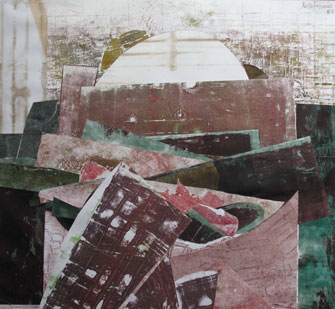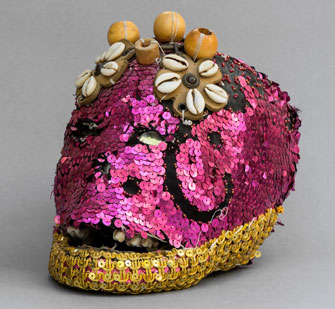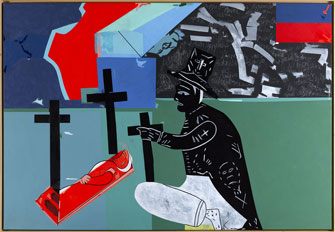A Survey of Haitian Art:
Beyond the Stereotypes

“Poste Ravine Pintade” (c. 1980), by Fritzner Lamour.
Not surprisingly, death looms large as subject matter in the exhibition “Haiti: Two Centuries of Artistic Creation” at the Grand Palais in Paris, whose intention is to upend the stereotype of naive, voodoo-influenced Haitian art and explore “the extraordinary vitality” of the country’s art, in which “the real country coexists strangely with a dream land.”
The dream can seem like a nightmare in this country so often ravaged by political violence and natural disasters, and the horror of its tragedies are clearly reflected in much of the art in this show, which covers a wide range of works from the 19th century to the present, arranged by theme, by some 60 artists.
One of the more riveting works is Patrick Vilaire’s “Le Fossoyeur” (“The Gravedigger,” 2012), in which a realistic sculpture of the upper body of the gravedigger lies stiff in a real wheelbarrow, dressed in a tie and white jacket, his head encased in a helmet. His missing legs are present in the flat shadow of his entire body on the ground.
Some works rise above the fray, eschewing dark subject matter, among them Luce Turnier’s beautiful and delicately colored collages from the 1960s, one of rooftops, another of stairways and another, more

“Nature Morte” (1969), by Luce Turnier. © Léonora Carpi
abstract piece entitled “Still Life.” Turnier (1924-94) lived away from Haiti for long periods, mostly in Paris, and was considered foreign by her compatriots and Haitian by foreigners, probably because her work was difficult to categorize; she was schooled in both Haiti and abroad, and her work had nothing of the “primitive” about it that outsiders expect of Haitian art. Her work, new to me, and full of portraits of Haitian women (not represented in the exhibition), was a pleasant surprise.
Another beautiful work that has nothing particularly “Haitian” about it is “La Missive” by Bernard Séjourné (1947-94), who, like Turnier, studied at The Art Students League of New York. He was one of the founders of the “School of Beauty,” which aimed to “honor the grace and elegance of women from a Surrealist perspective.” Unlike many of his other works, this painting of a girl reading a letter is not Surrealistic in the least, but it certainly is characterized by grace and elegance.
In a way, American artist Jean-Michel Basquiat (1960-88) was perhaps a more “Haitian” artist than either Turnier or Séjourné, although he never lived in his father’s native country. His paintings, three of which are included in the exhibition, are studded with voodoo references.
Other artists whose work deals overtly with voodoo include Dubréus Lherisson (born 1971), who is represented by a series of fantastical

“Untitled” (2012-13), by Dubréus Lhérisson. Photo: Josué Azor.
decorated human skulls beautifully adorned with glitter and various objects. One is topped with a delicate female figurine garbed in a fanciful wedding gown, which calls to mind Niki de Saint Phalle’s “Brides.”
Death is also given a beauty treatment in Préfète Duffaut’s “Mon Cerceuil” (“My Coffin, 1998), a real casket painted with a colorful port scene in a naive style.
Such stars of Haitian art past and present as Hector Hyppolite (1894-1948 and Hervé Télémaque (b. 1937) are also included in the

“Le Voyage d’Hector Hyppolite en Afrique” (2000), by Hervé Télémaque. © Paris, Musée d’Art Moderne/Roger-Viollet © Adagp, Paris, 2014
exhibition, but perhaps it is the less familiar artists who make this exhibition so affecting.
Although the content of “Haiti” is often grim, sometimes even frightening, you leave this show feeling somehow uplifted, perhaps because of that defiant vitality and humor in the face of so much horror and misery.
Galeries Nationales du Grand Palais: 3, avenue du Général Eisenhower, 75008 Paris. Métro: Champs-Elysées Clemenceau. Tel.: 01 44 13 17 17. Open Wednesday-Saturday, 10am-10pm (until midnight on October 4); Sunday-Monday, 10am-8pm. Closed Tuesday and December 25. Admission: €12. Through February 15, 2015. www.grandpalais.fr
Click here to read all of this week’s new articles on the Paris Update home page.
Reader Reaction: Click here to respond to this article (your response may be published on this page and is subject to editing).
Support Paris Update by ordering books from Paris Update’s Amazon store at no extra cost. Click on your preferred Amazon location: U.K., France, U.S.
© 2014 Paris Update
Favorite